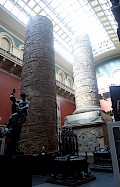Getting inspiration
Wargaming can be an all-encompassing hobby. As you play the games and paint the miniatures, there is a tendency to want to go deeper into it and read about the history, research the uniforms and so on. For me, this also involves visiting historical buildings (and ruins), battle sites and museums. There is nothing better than seeing primary sources and viewing them firsthand. Sometimes they can give you new insights into a period and potentially reflect those in future gaming.
 I recall visiting a Samurai exhibit at the Royal armouries some years ago and seeing an original screen depicting the battle of Nagashino in 1575. There was every aspect of the battle (as I knew it) with the proper clan mons and the traditional turn of the battle: the moment where Takeda charged the barricades and was gunned down by the Oda Tokugawa matchlocks. That is, except for a few extra features, namely a dam. ‘A dam’ you say? Yes, a dam! The screen showed that the river had been dammed downstream to make the crossing point by the castle deliberately muddy. It also showed ashigaru disguising the flooded ground with reeds and grass. This information would suggest that the battle was also won by clever preparation of the ground and not just the revolutionary teppo firearm.
I recall visiting a Samurai exhibit at the Royal armouries some years ago and seeing an original screen depicting the battle of Nagashino in 1575. There was every aspect of the battle (as I knew it) with the proper clan mons and the traditional turn of the battle: the moment where Takeda charged the barricades and was gunned down by the Oda Tokugawa matchlocks. That is, except for a few extra features, namely a dam. ‘A dam’ you say? Yes, a dam! The screen showed that the river had been dammed downstream to make the crossing point by the castle deliberately muddy. It also showed ashigaru disguising the flooded ground with reeds and grass. This information would suggest that the battle was also won by clever preparation of the ground and not just the revolutionary teppo firearm.
Recently, I set aside a few days for some time in London with my girlfriend Emma. While we were there, we took the opportunity of attending two museums, The Victoria & Albert Museum and The British Museum. The V&A is an art & design museum, and I knew that it housed among its many exhibits in the Cast Courts a copy of Trajan’s column made in 1864. The original is so tall that it is divided into two sections to fit into the casting halls. Given that the column in Rome has suffered much from polluted wind and weather over the last century (and because you can get much closer at the V&A), details are easier to distinguish on the copy in the V&A (and for even easier viewing, try the individual panel casts at the Museum of Roman Civilization in Rome). The column clearly shows Roman and Dacian armour, shields and equipment from the time of Trajan, including spoils of war, such as Dacian carnyx, scale armour, helmets and the famous falx. More information on Trajan’s Column can be found here and on the Dacian Wars, the equipment on this Column as well as the Adamklissi monument, see Ancient Warfare VI.2.
 We also visited the British museum, which famously houses countless exhibits covering from the entire range from the Biblical era to the present day and covering all corners of the globe. If pushed, I’d have to say that the highlight for me had to be the some of the Assyrian stone relief panels from the palace of Tiglath-Pileser III. Among more warlike scenes, these panels show various scenes of lion hunting. We covered this recently in WSS 65 with Mark Backhouse’s excellent ’ Assyrian lion hunt’ article (they’re also important sources for Assyrian warfare!). It was good to see the originals, which included lions being released from crates (it’s all a setup gov!) and other animal hunting scenes. In one bizarre scene, a servant approaches with a selection of small birds on a serving tray as some form of Assyrian ‘haute cuisine’.
We also visited the British museum, which famously houses countless exhibits covering from the entire range from the Biblical era to the present day and covering all corners of the globe. If pushed, I’d have to say that the highlight for me had to be the some of the Assyrian stone relief panels from the palace of Tiglath-Pileser III. Among more warlike scenes, these panels show various scenes of lion hunting. We covered this recently in WSS 65 with Mark Backhouse’s excellent ’ Assyrian lion hunt’ article (they’re also important sources for Assyrian warfare!). It was good to see the originals, which included lions being released from crates (it’s all a setup gov!) and other animal hunting scenes. In one bizarre scene, a servant approaches with a selection of small birds on a serving tray as some form of Assyrian ‘haute cuisine’.
So did I learn something new? I may not have made any ground breaking discoveries, but it was amazing to see the originals (or near originals). Well worth seeing if you have the chance, and it certainly provided inspiration to put a lick of paint on my Dacian and Assyrian armies. After I’m done with my French army for Ligny, that is…
